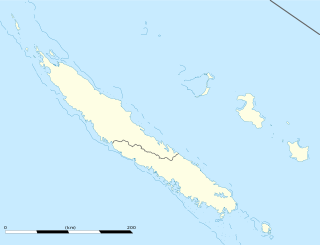Pindai Caves
| Pindai Caves
|
||
|---|---|---|
| Location: | Nepoui , New Caledonia | |
|
Geographic location: |
21 ° 20 ′ 0 ″ S , 164 ° 57 ′ 0 ″ E | |
|
|
||
| Discovery: | 1983 | |
| Particularities: | Fossil deposit | |
The Pindai Caves are a complex of six caves located on the Pindai Peninsula on the west coast of New Caledonia about 240 km northwest of Nouméa . The caves are 400 m from the sea, with the exception of Pindai II, which is only 20 m from the coast.
The site is known as a paleontological site where subfossil remains of the extinct giant tortoise Meiolania and extinct bird species have been found. The first fossils were discovered here on July 3, 1983 by Jean-Christophe Balouet , who found a complete skull of the species Sylviornis neocaledoniae on the cave floor just 2 m from the entrance . The debris in the main cave is believed to have accumulated at the bottom of an underground lake that previously filled the cave. The sediments in the main part of the cave consist of phosphates and magnesium alumina with several embedded layers of gypsum, 2 to 10 cm deep, which were formed during the dry periods when the cave was not yet flooded.
Bone clusters were found in two places near the side exits, which are now filled with unlayered sediment. Bones occur both on the surface and at depths up to 1.5 m where the excavation stopped. The bone concentration was very high. More than 6,000 bones were brought to the surface in less than 3 m³ of earth. Mollusc shells, particularly those of Arca , Ostrea, and Nautilus , believed to have been transported into the caves by humans, were fairly common in much of the debris. The charcoal, which was taken in direct contact with bones from Sylviornis and other extinct birds, has a radiocarbon dating of 1750 ± 70 years BP , which corresponds to the period 130 to 270 AD. Sylviornis neocaledoniae is the most common species found in the Pindai Caves. Of the 23 other species, 8 are also extinct and only 7 are still in existence. Four of the extinct species are known only from the Pindai Caves. These are Caloenas canacorum , the New Caledonian earth dove ( Gallicolumba longitarsus ) and the two raptors Accipiter efficax and Accipiter quartus . More common than the bird bones are those of bats (at least four species). Over 1,000 bones of extinct reptiles, including the genera Mekosuchus , Meiolania, and Varanus , are also known.
The accumulation of bones in this site apparently does not contain any deposits in owl wool, as most of the small bird species are missing and the remains of passerine birds have only been found very rarely. Cave-dwelling species such as bats and sailors ( collocalia ) are common in the subfossil deposits and the presence of the other species is believed to be due to capture or transport by humans. The sediment was washed out of the deposits in cooperation with the water and forest service of Nouméa and Koné . Large bones were removed in the field and the resulting concentrate was used to read the small bones at the Smithsonian Institution . An adjacent cave contains an underground lake with deep, treacherous accumulations of mud. In this lake Balouet found the single thigh bone of the endemic split-winged pigeon ( Drepanoptila holosericea ). Pindai II is a small cave with an area of 5 m² and a height of 50 cm. It was discovered in 1983. Three bones of the giant fruit pigeon ( Ducula goliath ), the complete basin of the flightless fur rail ( Gallirallus lafresnayanus ) and three skulls of humans were discovered here.
literature
- J.-C. Balouet & SL Olson: Fossil Birds from Late Quaternary Deposits in New Caledonia In: Smithsonian Contributions to Zoology. No. 469. Smithsonian Institution Press, Washington DC, 1989: p. 4-5
- Atholl Anderson, Christophe Sand, Fiona Petchey & Trevor H. Worthy : Faunal Extinction and Human Habitation in New Caledonia: Initial Results and Implications of New Research at the Pindai Caves In: Journal of Pacific Archeology - Vol. 1 No. 1 2010: p. 89-109
